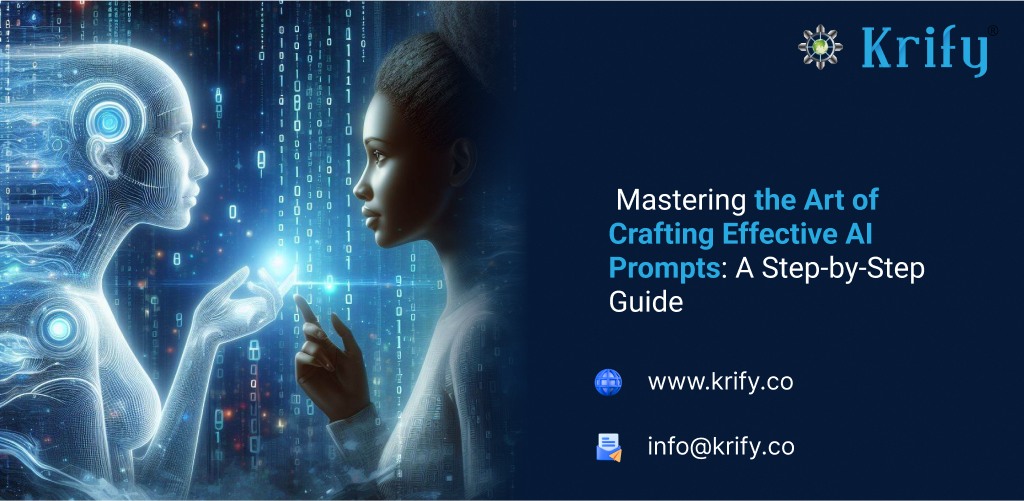In today’s digital era, harnessing the power of artificial intelligence (AI) has become paramount for various tasks, ranging from generating creative content to assisting in decision-making processes. However, the effectiveness of AI largely depends on the quality of prompts provided to it. Crafting an effective AI prompt requires a nuanced approach, blending clarity, specificity, and creativity. In this article, we’ll delve into the art of crafting compelling AI prompts and outline a step-by-step formula to guide you through the process. Learn to master the art of crafting effective AI prompts with our comprehensive guide. Enhance your AI interactions and achieve results!
Step 1:
Define Your Objective Before diving into crafting a prompt, clearly define
your objective. Are you seeking to generate creative content, solve a complex
problem, or simply gather insights? Understanding your goal will help you tailor your
prompt accordingly and ensure that the AI generates relevant outputs.
Step 2:
Understand Your Audience Consider who will be interacting with the AI-
generated content. Understand their preferences, interests, and expectations. This
understanding will guide the tone, style, and content of your prompt, making it more
engaging and effective.
Step 3:
Be Specific and Clear Clarity is key when crafting AI prompts. Clearly
articulate what you want the AI to do or achieve. Avoid ambiguity and vagueness, as
they can lead to irrelevant or off-topic outputs. Provide specific instructions,
constraints, or examples to guide the AI's response.
Step 4:
Provide Relevant Context Contextual information can significantly enhance
the effectiveness of AI prompts. Provide background information, relevant data
points, or examples to help the AI understand the task at hand better. This context
enables the AI to generate more accurate and meaningful responses.
Step 5:
Encourage Creativity While clarity and specificity are essential, don't stifle
creativity. Encourage the AI to think outside the box and explore novel ideas or
perspectives. Incorporate open-ended questions or prompts that prompt creative
thinking and innovation.
Step 6:
Iterate and Refine Crafting effective AI prompts often requires iteration and
refinement. Test different variations of prompts, gather feedback, and iterate based
on the results. Continuously refine your prompts based on the AI's outputs and the
desired outcomes.
Step 7:
Evaluate and Adjust After generating AI-generated content, evaluate its
effectiveness against your objectives. Assess whether the outputs meet your
expectations, address the audience's needs, and align with your goals. Based on this
evaluation, adjust your prompts as needed to improve future interactions with the AI.
By following these steps, you can master the art of crafting effective AI prompts that
yield meaningful and valuable outputs. Whether you're leveraging AI for content
generation, problem-solving, or decision support, thoughtful and well-crafted prompts are the cornerstone of success. Embrace creativity, clarity, and iteration in your prompt-writing process, and unlock the full potential of artificial intelligence.
Crafting Effective Prompts for Image Generation and UI/UX Design: Best
Practices Unveiled
In the realm of artificial intelligence, the power to generate images and design user
interfaces (UI) and user experiences (UX) is increasingly being harnessed to
streamline creative workflows and enhance digital interactions. However, to leverage
AI effectively in these domains, one must master the art of crafting prompts that
effectively communicate desired outcomes to the AI models. In this article, we’ll
explore the nuances of prompting for image generation and UI/UX design and outline
best practices to guide your prompt-writing process.
Define Clear Objectives:
Start by defining clear objectives for the image generation or UI/UX design task. Are you aiming to create realistic images,
abstract artwork, or specific UI components? Understanding your goals will help you tailor your prompts accordingly and guide the AI model towards generating relevant outputs.
Provide Detailed Instructions:
Be specific and provide detailed instructions to the AI model regarding the desired output. For image generation, specify
factors such as the subject matter, style (e.g., photorealistic, abstract), color palette, and composition. For UI/UX design, outline the desired features, layout, typography, color scheme, and user flow.
Offer Visual References:
Visual references serve as invaluable guidance for both image generation and UI/UX design prompts. Include reference images, sketches, mood boards, or existing UI designs that convey the aesthetic, mood, and functionality you're aiming for. This helps the AI model better understand your vision and generate outputs that align with your expectations.
Consider Context and Use Cases:
Context is crucial when prompting for image generation and UI/UX design. Consider the intended context and use cases for the generated images or designs. Whether it's for marketing materials, product prototypes, or user interfaces, tailor your prompts to suit the specific context and requirements.
Balance Specificity and Flexibility:
Strive to strike a balance between specificity and flexibility in your prompts. While providing clear instructions is essential, allowing room for creative interpretation can lead to more diverse and innovative outputs. Encourage the AI model to explore different variations while staying true to the core objectives.
Iterate and Refine:
Crafting effective prompts often requires iteration and refinement. Experiment with different prompts, observe the AI model's responses, and iteratively adjust your approach based on the results.
Evaluate and Iterate:
After receiving the generated images or UI/UX designs, evaluate them against your objectives and requirements. Assess whether they meet the desired aesthetic, functionality, and usability criteria. Gather feedback, iterate on your prompts, and refine the process to achieve better results over time.
By following these best practices, you can craft effective prompts for image
generation and UI/UX design that empower AI models to produce high-quality
outputs aligned with your creative vision and objectives. Embrace clarity, specificity,
contextuality, and iterative refinement in your prompt-writing process, and unlock the
full potential of AI in transforming digital creativity and user experiences.



